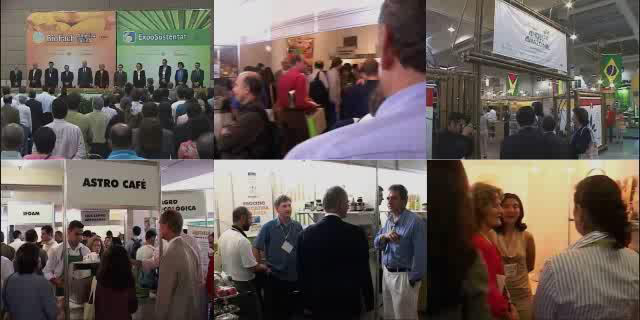Português e Inglês

www.planetaorganico.com.br
Referência na internet sobre o setor orgânico do Brasil
___________________________________________________________
Seminário BioFach Brasil

________________________________________________________________________________________________
Seminários BioFach América Latina



Participants
Participant Countries: Bolivia, Brazil, Colombia, Ecuador, Peru

Sectors
- Natural ingredients for the food and cosmetics sectors
a) Fresh and processed food products (herbs, fruits, spices, etc.)
b) Essential oils, oleoresins, gums, resins, natural colorings, pigments and dyes - Handicrafts, jewelry and natural fibers
- Sustainable tourism
- Wild Fauna


 1 – CASTANHABREU BRANCO
1 – CASTANHABREU BRANCO
2 – ANDIROBA
3 – MURU MURU
4 – PRIPRIOCA
5 – CUPUAÇU
6 – GUARANÁ
7 – MARACUJÁ
8 – PITANGA
9 – BURITI
10 – CAMOMILA
11 – MATE VERDE
________________________________________________________________________________________________
 The Biomes
The Biomes
- Cover 35% of the Brazilian territory
- Two of the wealthiest biomesin the planet in terms of biodiversity
- Home to important rivers
- Shelter over 40% of the Brazilian family farming
- Greatsocioculturaland productive diversity
- Potential to valuingsociobiodiversityproducts
- Permanent and open networking
- Composition: 200 enterprises, 20 thousand families,20 networks and 14 Brazilian states
- Partnership with the Federal Government, German Cooperation and Non-Governmental Organizations
________________________________________________________________________________________________

________________________________________________________________________________________________


________________________________________________________________________________________________
 Main Organic Products
Main Organic Products
Fruit: guavas, papayas, mangoes, passion fruit, bananas, grapes, strawberries, citrus fruit
Vegetables: lettuce, kale, tomatoes, carrots, water-cress, aubergines
Field Crops: rice, soy beans, maize, manioc, coffee, cacao and sugar cane
Animal Produce: meat (beef and pork), poultry, milk, eggs, fish and honey
Extractive Products: palm hearts, Brazil nuts, cashew nuts, cabbage palm (açaí), babassu
________________________________________________________________________________________________
Major Non-Processed Organic Products
Fruits: guava, papaya, mango, passion fruit, banana, grapes, strawberry and citrus

Culture: cotton, rice, soyabean, corn, wheat, tapioca, coffee, cocoa and sugar cane

Extrativism: Pupunha Palm, Brazil Nuts, Nuts, açaí, babaçu, palm, cocoa

________________________________________________________________________________________________
 Brazilian Organic Ssctor’s Legislation
Brazilian Organic Ssctor’s Legislation
Art. 117, O Ministro de Estado da Agricultura, Pecuária e Abastecimento, no âmbito de sua competência, expedirá os atos ao cumprimento deste Decreto.
Art. 118, Este Decreto entra em vigor na data de sua publicação..
Brasília, 27 de dezembro de 2007; 186 o da independência e 119 o da República.
LUIZ INÁCIO LULA DA SILVA
Reinhold Stephanes
Miguel Jorge
José Gomes Temporão
João Paulo Ribeiro Capobianco
Guilherme Cassel
________________________________________________________________________________________________
Essential Oils & Traditional Knowledge
Traditional Knowledge of the use of the flora can reduce the costs of research for the identification and synthetization of the basic elements of drugs by over 50%.
That means savings in costs and also in time spent in searching for active principles for the production of new pharmaceutical drugs.

________________________________________________________________________________________________

________________________________________________________________________________________________

________________________________________________________________________________________________

________________________________________________________________________________________________
Brazil
Green opportunities and challenges at World Cup 2014

________________________________________________________________________________________________
What will be the social and environmental impacts?
How many families will benefit before, during and after the World Cup?
12 different cities.
•Transmission coverage in over 200 countries
•Over 50,000 new jobs will be created during the World Cup, and 1/3 in the safety, hotel and restaurant areas.

________________________________________________________________________________________________

________________________________________________________________________________________________

________________________________________________________________________________________________
Germany World Cup 2006
Growth sectors during World Cup 2006
Hotel and food sector: 29%
Food industry: 24%
Airlines companies: 52%
Audio-Visual and Midia: 25%
Publicity: 18%
Source: DIHK (Der Deutsche Industrie-und Handelskammertag –

________________________________________________________________________________________________
BRAZIL: Main Statistics –Base Year 2006
| Total area | 851 million ha |
|
Total area of rural establishments |
330 million ha |
|
Production Units |
5,175,240. |
|
Family Farms –Workforce |
15.3 persons/100 ha |
|
Family Farms –VBP |
54 billion Reals/year (38%) -R$ 677/ha |





